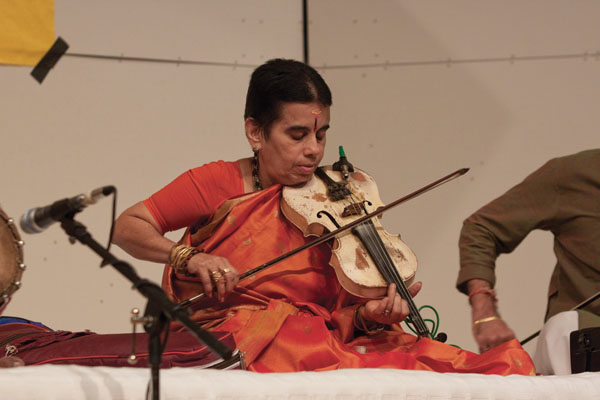Violinist wows crowd with eclectic sound

violinist1:Dr. Kanyakumari, brought Indian violin music to Sac State Friday night in Capistrano Hall for a World Music concert. :Julie Keefer – State Hornet
September 13, 2010
World-renowned South Indian Carnatic violinist Avasavala Kanyakumari performed at Sacramento State on Friday, showcasing a complex and traditional style of music that dates back centuries.
Kanyakumari was accompanied by Shrimushnam Raja Rao on the mridangam (percussion) and her student, Embar Kannan, on the violin. The performance was entirely instrumental.
A short, elevated stage was placed on the main stage with a white cloth draped over it. Here is where the performers sat cross-legged. Kanyakumari announced the raga and the tala which served as the melodic and rhythmic framework of each song.
All three of the musicians have been playing music since a young age. It takes an immense amount of practice and dedication to reach the level of skill that they have.
Kanyakumari and Kannan played their violins in perfect harmony through much of the performance without missing a note.
The mridangam is a small, cylindrical drum that is laid horizontally and played from both ends. Raja Rao’s most impressive display of skill came in the second half of the performance when he played a drum solo more than 10 minutes long. The audience could not help but feel the rhythm as heads nodded and feet tapped.
Zephyr Uber, junior music composition major, said his favorite part of the concert was “the 10 minute long wicked drum solo.”
It was striking to listen to the wide variety of tones issuing from the mridangam, which at first glance seems like a relatively simple instrument. Raja Rao’s hands flew at amazing speed during the faster sections.
The Carnatic music structure allows for sections of improvisation from the musicians. During many of these sections, the musicians seemed to communicate with each other through their instruments. Kanyakumari would play an improvised melody, and Kannan would respond by mimicking the melody or complementing it with a similar one.
During the improvised sections the musicians worked very well together in order to make the music flow.
“Sometimes anticipation matches so well, we smile at each other,” Kannan said.
Kannan and Kanyakumari occasionally used hand gestures and clapping in order to keep the tala, or rhythmic framework, on point.
The acoustics in the room complemented the instruments, especially the mridangam. The multi-rhythmic drumming reverberated off the walls, surrounding the audience with intricate beats.
In order to really appreciate the music on a deeper level, you must devote a certain amount of time to study the complex structure of the raga and the tala. Kannan said this was the most important aspect of the performance.
“We enjoy the discipline of the audience,” he said in relation to the study of the raga and the tala.
Kanyakumari said what she liked most about the performance was the audience and their response to the music.
Many members of the audience were taking notes and attempting to recognize the structure of the raga and tala. It takes time and practice in order to understand the arrangement of Carnatic music, and the performers appreciated peoples’ willingness to learn.
In 1988, Kanyakumari performed Carnatic music on her violin for 29 straight hours without repetition.
“If we have willpower, we can do anything,” Kanyakumari said.
Tzahuiztil Sanchez can be reached at [email protected]



































































































































